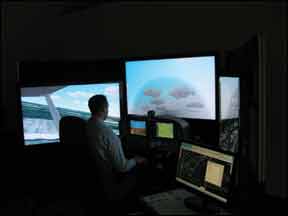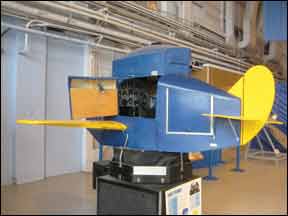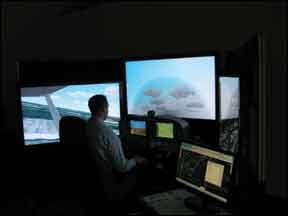I’ve been teaching people how to fly airplanes for 28 years now, and at this point people tell me I’m pretty good at it. One of the things I learned early on is that the cockpit environment is a horrible classroom in which to teach the basics of flight. It’s noisy, full of distractions, occasionally unpredictable and constantly moving. It should not be a secret to even the newest flight instructor that all of this is a challenge to a typical primary student’s senses. Frankly, any sane human being is scared of it, at first, though few would admit to it.

288
With all that in mind, it’s a shame technology hasn’t blessed us with some device we can use on the ground, in a quiet, low-stress training environment, to teach students fundamental procedures, introduce them to complex systems or repetitively practice the kinds of emergencies that are either impractical or impossible to do in the air. We might call that device a…flight simulator! Thankfully, technology has caught up with demand, and the latest devices sport vast improvements in capabilities, reliability and the overall quality of the training experience.
Flight Sims Reach Maturity
While we’re confessing, here’s another little-talked-of industry secret: Flight instruction is a life-and-death struggle for your typical certificated flight instructor (CFI), who has to keep the airplane from killing anyone while avoiding violating any number of FAA regulations. And he or she has to do this as while simultaneously teaching a planned lesson and transferring knowledge to the aforementioned overwhelmed student. Try it sometime. It’s harder than it looks.
Ground school evolved from these realizations. Even though most flight instructors dislike teaching on the ground, they will, as a group, acknowledge the benefits of imparting knowledge in quiet, well-lit, relaxed environments. On the ground, CFIs can better control how any flight lesson is going to play out. Why? Because they hold most of the cards: There are no sudden ATC amendments to lesson plans, no unexpected flashing alternator-out lights, no tilted, giving-up-the-ghost gyros mid-lesson (unless we choose it) and no unanticipated airspace restrictions or weather anomalies. Total control. Ah…every teacher I know, no matter of what discipline or age group, will tell you that really does feel good.
Flight simulation by computer is just an extension of all the good that ground school imparts to students. This is particularly true when trying to teach instrument-flying skills to a pilot. That is because under instrument meteorological conditions, hand-eye coordination is everything. If the pilot’s eyes can correctly interpret the visual information the analog or digital instrumentation is presenting to him while flying in the clouds and can turn that information into the proper control inputs to keep the aircraft on track, right-side up, then he lives. Get it wrong, or trust another sense, say, the kinesthetic sense, above vision, and, well, things don’t turn out so well. In IFR, the brain interprets just what the eyes see and nothing else. Simple as that.
A Brief History of Sims
If you subscribe to this basic tenet of instrument flying philosophy (and most of us CFIIs, as well as the FAA, do) then you can understand, by extension, why and how a simple PC digital flight simulation presented on a nice, big LED screen (or a few of them) can be such an effective tool for training someone on how to interpret flight instrumentation with their eyes. It doesn’t need to move. In fact, for much of the basic instrument training we do, it shouldn’t.
Hear me out. Yes, the first flight simulators, the Link Trainers, had motion. The original Link Trainer was created in 1929 out of the need for a safe way to teach new pilots how to fly by sole reference to instruments on the aircraft panel. Our national hero, Jimmy Doolittle, was a pioneer of the basic instrument scanning techniques we still use today, and he was one of the first of millions of pilots to use a Link Trainer, too.
Ed Link used his knowledge of pumps, valves and bellows (honed building organs in his day job) to create a flight simulator that responded to the pilot’s controls and gave an accurate reading on the instrument panel. These simulators were little blue plywood boxes with real gyro instruments inside and the reason they moved is because they had to so that those gyros in the instruments would work as they did during true flight.
“Please don’t put me in that box,” many a trainee begged. It was a tight fit for the big guys. Dark. Hot. And smelly if the pilot before you perspired heavily or tended toward motion sickness. Claustrophobia isn’t innate—for a lot of us it was an “earned” malady. No wonder few civilian pilots wanted to use them.
But today, we don’t need motion or small, dark boxes to simulate instrument flight. Even companies such as Frasca and Redbird Simulations, which make motion simulators, would agree (hey, they make fixed flight training devices, too, so that to me is a de facto “yes”). The modern computer programs teaching flight by reference to aircraft panel instruments range from hokey and video game-like, but pictorially effective, to extremely sophisticated flight training devices that are accurate in control feel. They can be tight and simple, such as the ASA On Top PCATD trainer, which is designed to impart basic instrument skills and proficiency with maximum instructor flexibility. Or they can be extremely realistic on a visual and sensual level, with so much flexibility that pilots and flight schools who want to use the program need customized plug-ins (or the ability to create them) and high-powered CPUs to make the programs work effectively.

288
The hardware, even more than the software, is key to whether the training can be logged toward a rating or toward proficiency.
Taking It To The Streets
Back in the 1970s, Peter Dogan pioneered the 10-day IFR rating program delivered to your door by combining the ATC-610 flight training device with intensive flight training. That model has inspired many programs today, with providers meeting needs like odd hours and different locations. Increasingly, sim providers are going the extra mile—sometimes literally—to bring training to the customer.
One example is Holladay Aviation, in Gaithersburg, Maryland. Holloday offers its clients an FAA-approved Elite PI-135 Basic Aviation Training Device (BATD) that can be used to log 2.5 hours of training toward a private certificate or 10 hours toward an instrument rating. It also can be used for recurrent instrument experience, but not for an instrument proficiency check.
“We’ve installed the Elite in our Honda minivan so we can deliver this virtual cockpit to clients anywhere in the Washington, D.C., metro area,” said co-owner and CFI at Holladay Aviation, Meredith Holladay. The company charges $50 an hour plus travel expenses for the BATD. “I’ve developed a customized syllabus that covers all of the basics, including scan familiarization, basic IFR mechanics and reasoning, and multi-tasking skills such as briefing an approach while controlling an airplane and navigating. These are the toughest skills and concepts to introduce in a moving aircraft cockpit. The BATD is an ideal teaching device for them,” she continued. Beyond that, she said, “People like the mobile BATD because it fits in their schedule.”
The unique setup is cozy enough to simulate a cockpit and private enough for clients to feel comfortable in the learning process. “Once you get going on a lesson, it’s really quite comfortable,” explained Holladay.
Elite Simulations has been in the business a long time and its many varied products are well-received in the industry, but it faces tough competition from the likes of Redbird (its mobile-capable tabletop FTD marketed by King Schools), FlyIt Sims, the FTS TouchTrainer and a few other up-and-comers. All have the ability to mimic with accuracy both analog panels and the latest Garmin products, and a few can be customized for your specific needs (such as if you have non-Garmin EFIS in your panel). Base pricing ranges from $3,000 to $11,000 for FAA-approved devices, so, these products are not typically purchased outright by individual pilots searching for currency or a rating upgrade. That said, they are definitely in the affordability range of even smaller Part 61 flight schools or the active independent CFII, and beat the heck out of the cost of a motion sim, which starts above $40,000.
The Holladays are essentially a mom-and-pop operation, and Meredith told us their thinking in investing in the Elite BATD was simple. “We wanted to help our students save money, as much as $1000 on an IFR rating, and it expedites their training because it is a better environment for learning basic skills.” And as for their clients? “The response has been positive,” replied Holladay.
Beyond saving money, the BATD allows clients to train on bad weather days and with scenarios that take them out of their comfort zones. Tough training can even be fun! No wonder CFIs like them, too.
Amy Laboda is a freelance writer, ATP, CFII-MEI and a National Lead FAAst Team representative. She and her husband own and fly a Kitfox and an RV-10.




